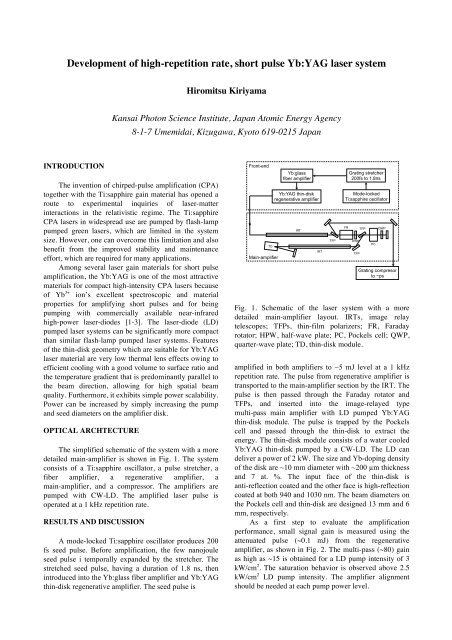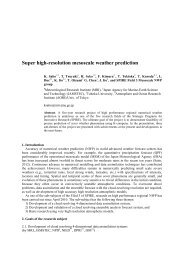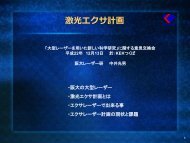Development of high-repetition rate, short pulse ... - Osaka University
Development of high-repetition rate, short pulse ... - Osaka University
Development of high-repetition rate, short pulse ... - Osaka University
- No tags were found...
Create successful ePaper yourself
Turn your PDF publications into a flip-book with our unique Google optimized e-Paper software.
<strong>Development</strong> <strong>of</strong> <strong>high</strong>-<strong>repetition</strong> <strong>rate</strong>, <strong>short</strong> <strong>pulse</strong> Yb:YAG laser systemHiromitsu KiriyamaKansai Photon Science Institute, Japan Atomic Energy Agency8-1-7 Umemidai, Kizugawa, Kyoto 619-0215 JapanINTRODUCTIONThe invention <strong>of</strong> chirped-<strong>pulse</strong> amplification (CPA)together with the Ti:sapphire gain material has opened aroute to experimental inquiries <strong>of</strong> laser-matterinteractions in the relativistic regime. The Ti:sapphireCPA lasers in widespread use are pumped by flash-lamppumped green lasers, which are limited in the systemsize. However, one can overcome this limitation and alsobenefit from the improved stability and maintenanceeffort, which are required for many applications.Among several laser gain materials for <strong>short</strong> <strong>pulse</strong>amplification, the Yb:YAG is one <strong>of</strong> the most attractivematerials for compact <strong>high</strong>-intensity CPA lasers because<strong>of</strong> Yb 3+ ion’s excellent spectroscopic and materialproperties for amplifying <strong>short</strong> <strong>pulse</strong>s and for beingpumping with commercially available near-infrared<strong>high</strong>-power laser-diodes [1-3]. The laser-diode (LD)pumped laser systems can be significantly more compactthan similar flash-lamp pumped laser systems. Features<strong>of</strong> the thin-disk geometry which are suitable for Yb:YAGlaser material are very low thermal lens effects owing toefficient cooling with a good volume to surface ratio andthe temperature gradient that is predominantly parallel tothe beam direction, allowing for <strong>high</strong> spatial beamquality. Furthermore, it exhibits simple power scalability.Power can be increased by simply increasing the pumpand seed diameters on the amplifier disk.OPTICAL ARCHTECTUREThe simplified schematic <strong>of</strong> the system with a moredetailed main-amplifier is shown in Fig. 1. The systemconsists <strong>of</strong> a Ti:sapphire oscillator, a <strong>pulse</strong> stretcher, afiber amplifier, a regenerative amplifier, amain-amplifier, and a compressor. The amplifiers arepumped with CW-LD. The amplified laser <strong>pulse</strong> isope<strong>rate</strong>d at a 1 kHz <strong>repetition</strong> <strong>rate</strong>.RESULTS AND DISCUSSIONA mode-locked Ti:sapphire oscillator produces 200fs seed <strong>pulse</strong>. Before amplification, the few nanojouleseed <strong>pulse</strong> i temporally expanded by the stretcher. Thestretched seed <strong>pulse</strong>, having a duration <strong>of</strong> 1.8 ns, thenintroduced into the Yb:glass fiber amplifier and Yb:YAGthin-disk regenerative amplifier. The seed <strong>pulse</strong> isFront-endTDMain-amplifierYb:glassfiber amplifierYb:YAG thin-diskregenerative amplifierIRTIRTGrating stretcher200fs to 1.8nsMode-lockedTi:sapphire oscillatorGrating compresorto ~psFig. 1. Schematic <strong>of</strong> the laser system with a moredetailed main-amplifier layout. IRTs, image relaytelescopes; TFPs, thin-film polarizers; FR, Faradayrotator; HPW, half-wave plate; PC, Pockels cell; QWP,quarter-wave plate; TD, thin-disk module.amplified in both amplifiers to ~5 mJ level at a 1 kHz<strong>repetition</strong> <strong>rate</strong>. The <strong>pulse</strong> from regenerative amplifier istransported to the main-amplifier section by the IRT. The<strong>pulse</strong> is then passed through the Faraday rotator andTFPs, and inserted into the image-relayed typemulti-pass main amplifier with LD pumped Yb:YAGthin-disk module. The <strong>pulse</strong> is trapped by the Pockelscell and passed through the thin-disk to extract theenergy. The thin-disk module consists <strong>of</strong> a water cooledYb:YAG thin-disk pumped by a CW-LD. The LD candeliver a power <strong>of</strong> 2 kW. The size and Yb-doping density<strong>of</strong> the disk are ~10 mm diameter with ~200 µm thicknessand 7 at. %. The input face <strong>of</strong> the thin-disk isanti-reflection coated and the other face is <strong>high</strong>-reflectioncoated at both 940 and 1030 nm. The beam diameters onthe Pockels cell and thin-disk are designed 13 mm and 6mm, respectively.As a first step to evaluate the amplificationperformance, small signal gain is measured using theattenuated <strong>pulse</strong> (~0.1 mJ) from the regenerativeamplifier, as shown in Fig. 2. The multi-pass (~80) gainas <strong>high</strong> as ~15 is obtained for a LD pump intensity <strong>of</strong> 3kW/cm 2 . The saturation behavior is observed above 2.5kW/cm 2 LD pump intensity. The amplifier alignmentshould be needed at each pump power level.TFPFRHWPTFPTFPPCQWP
Figure 2 shows the measured amplified <strong>pulse</strong>spectrum. The amplified spectral bandwidth is 1.4 nm.Although the amplified bandwidth is narrowed due togain narrowing, the spectral bandwidth would be broadenough to obtain the picosecond <strong>pulse</strong> after thecompression.Coordination Fund (SCF) for Promoting Science andTechnology commissioned by the Ministry <strong>of</strong> Education,Culture, Sport, Science and Technology (MEXT) <strong>of</strong>Japan, and partly the “Consortium for Photon Scienceand Technology” (CPhoST) program funded by the SCF,MEXT.REFERENCE(S)[1] T. Metzger, A. Schwarz, C. Y. Teisset, D.Sutter, A. Killi, R. Kienberger, and F Krausz, Opt.Lett., 34, 2123 (2009).[2] J. Tummler, R. Jung, H. Stiel, P. V. Nickles,and W. Sandner, Opt. Lett., 34, 1378 (2009).[3] S. Klingebiel, C. Wandt, C. Skrobol, I. Ahmad,S. A. Trushin, Z. Major, F. Krausz, and S. Karsch:Opt. Exp., 19, 5357 (2011).Fig. 1. Measured small signal gain from image-relayedmulti-pass amplifier as a function <strong>of</strong> LD pump intensity.Fig. 2. Measured amplified <strong>pulse</strong> spectra.CONCLUSIONWe have designed relay-imaged type multi-passYb:YAG thin-disk amplifier and have evaluated thefundamental system performance such as small signalgain and amplified spectral bandwidth. We plan toincrease the seed energy to the amplifier and LD pumpintensity, to demonst<strong>rate</strong> <strong>high</strong> energy, <strong>high</strong> averagepower operation as a next step.ACKNOWLEGEMENTSThis work was performed under the joint researchproject <strong>of</strong> the Institute <strong>of</strong> Laser Engineering, <strong>Osaka</strong><strong>University</strong>. This work was supported by the Special









